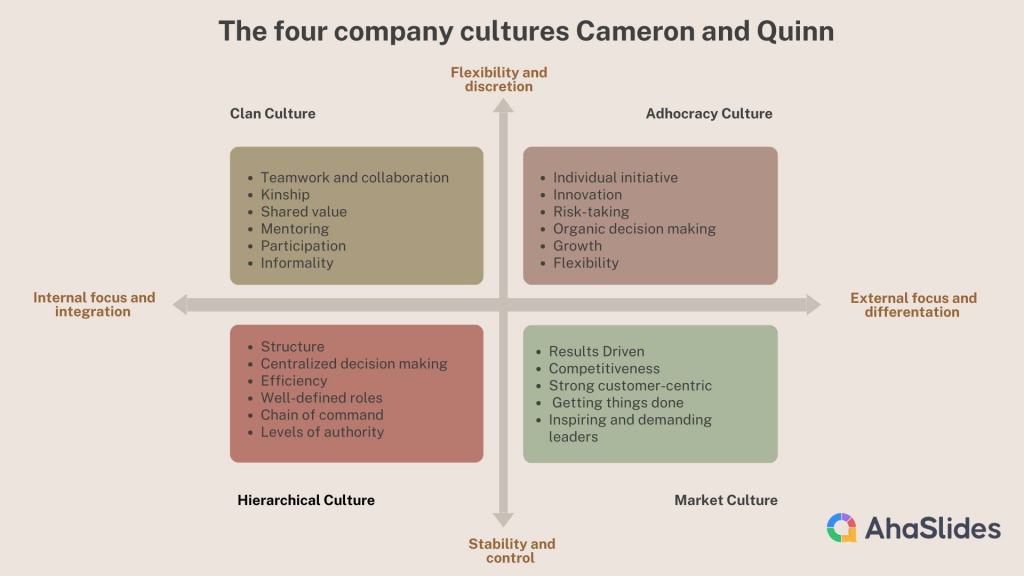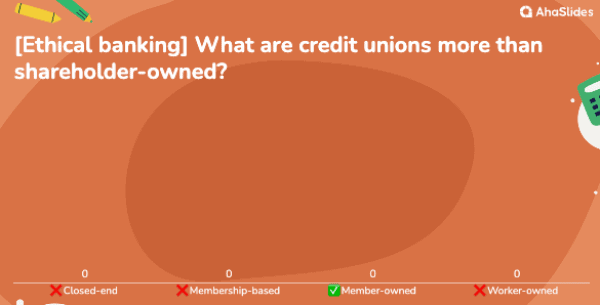Every organization has its own distinct DNA that shapes how employees behave, communicate and get things done.
But these cultures aren't one-size-fits-all.
Some thrive on controlled processes while others crave creativity.
This article introduces 9 common types of company culture, their concepts, and examples. Let's see which type of company culture fits your company's long-term strategic growth for the next decades.
Table of Contents
- What is a Good Company Culture?
- 4 Main Types of Company Culture
- Other Special Types of Company Culture
- How to Foster Great Company Culture
- Frequently Asked Questions
What is a Good Company Culture?
Good company culture is reflected in behaviors, attitudes, and values that are shared among the members of an organization, and how a company treats employees. It is also well-illustrated in management, workplace, and working hours. According to business professors Robert E. Quinn and Kim Cameron, no company culture is as precise as being “good” or “bad”, just distinct.
Related:
- Company Culture Examples | Best Practice in 2025
- Signs of a Toxic Work Environment and Best Tips to Avoid in 2025

Looking for More Fun During Gatherings?
Gather your team members by a fun quiz on AhaSlides. Sign up to take free quiz from AhaSlides template library!
🚀 Grab Free Quiz☁️
4 Main Types of Company Culture
"A Deloitte survey stated that 94 percent of executives and 88 percent of employees reckon a distinct workplace culture is significant to business thrive."
The classification of types of corporate culture is the Competing Values Framework. Let's take a look at the four common types of company culture that were identified by Robert E. Quinn and Kim Cameron nearly 40 years ago.

1. Hierarchical Culture
Hierarchical cultures are characterized by clear lines of authority and strict reporting structures. This type of company culture is often found in large, established organizations and government agencies. Decision-making authority typically flows from top management down through various levels of the organization.
Large financial institutions like JPMorgan Chase often have hierarchical cultures. They are led by the Operating Committee and are responsible for all strategy plans and decision-making. The hierarchy of the company is as follows Junior analyst - Senior analyst - Associate - Assistant VP - VP (Vice president) - ED (Executive director) - MD (Managing director).
2. Clan Culture
If you want to work in a great team clan culture is for you. This culture strongly emphasizes collaboration, shared values, and a sense of family or community within the organization. Teams often consist of individuals with diverse skills and expertise, bringing different perspectives to problem-solving and decision-making. It creates a team-based culture, where
Take Coca-Cola as a prime example. The company aims for a collaborative, inclusive workplace that empowers our employees to thrive. It encourages employees to create and plan competitive and innovative marketing to maintain market leadership.
3. Adhocracy Culture
Adhocracy Culture is a type of company culture where decision-making is decentralized throughout the organization, rather than being centralized in a few individuals or groups. It doesn't rely on a rigid system of authority or procedures. More importantly, it creates an informal atmosphere. This type of company culture appeared as the developed world shifted from the industrial era to the information era in the mid-1970s.

This type of company culture is well-illustrated in giants like Apple. The company has a collaborative structure organized by areas of expertise instead of product type and promotes innovation, forward-thinking, and individualism.
4. Market-driven Culture
Market-driven cultures are highly responsive to customer demand, market trends, profits, and competition. In this type of company culture, every employee competes with others with a motivation on revenue margins and results drive.
A great example is Tesla. Innovation is at the core of Tesla's culture. They continually innovate in battery technology, vehicle design, and self-driving capabilities to address evolving market trends and consumer preferences.
Other Special Types of Company Culture
The type of company culture can be examined and defined in more granular ways. Here are some special company culture types that are getting attention lately.
5. Startup Culture
Startup cultures encourage risk-taking and initiative. Employees are empowered to take ownership of their work and pursue new opportunities. It encourages a workplace environment where creative problem-solving, open communication, and a flat hierarchy are valued.
Startup culture is different from classic corporate culture because it naturally reflects the personalities and passions of the team members.
Take AhaSlides for example. Founded in 2019, AhaSlides now has 2 million active users worldwide. One of the team's biggest contributions to success is an honest and open environment

6. Creative Culture
Netflix is often associated with a unique and distinctive company culture that is commonly referred to as the "Netflix Culture". Actually, this is inspired by Creative culture or Innovation culture, where it is all about your people.
In Netfix, culture focuses on excellence, and values talented people who highly perform creatively and productively. That's why the core philosophy of the company is people over process, and they make great efforts to bring great people together as a dream team.
7. Customer-Focused Culture
Companies with a customer-centric culture put their customers at the center of everything they do. Employees in these organizations are encouraged to go above and beyond to meet customer needs. Long-term success is often tied to customer satisfaction and loyalty.
The best example of this type of company culture is the Ritz-Carlton hotel chain, which has long since demonstrated an organizational culture based on outstanding customer service. The company empowers every employee to deliver the best customer experience, from housekeeping to management, and can spend up to $2,000 per guest, per day, to resolve a problem without asking permission from a supervisor.
8. Fast-paced Culture
In a fast-paced culture, things happen quickly and continuously. In this type of company culture, workflows change and proceed rapidly, and you will find yourself quickly moving from one task to another without much time in between.
Besides collaboration, it consists of a high volume of independent work from all team members. You are often in the state of preparing for new and sometimes urgent tasks on brief notice. This type of company culture is often seen in startups where people rush to go ahead with market changes.
Another good example is Amazon. As the company offers competitive salaries and good opportunities for professional growth, they expect employees to work with high standards and workload, and quickly adapt to new technology and market changes.
9. Virtual Culture
After the pandemic, more companies used hybrid teams or networked teams that centered around a distributed workforce, where employees work primarily from remote locations rather than a centralized physical office. They utilized virtual communication and technology for almost all company activities and events. Performance is typically measured based on outcomes and results rather than hours worked or physical presence in an office in this type of company culture.
Take AhaSlides as an example. Ahaslides is a startup with networked teams from different backgrounds and locations. We invest in virtual team-building activities to foster a sense of rapport and connection among remote employees.

How to Foster Great Company Culture
Here are some suggestions for improving company culture, creating the best workplace for employees to produce high-quality work, innovate, and achieve company goals.
- Lead by Example: Leadership plays a crucial role in shaping company culture. Leaders should embody the values and behaviors expected from employees.
- Empowerment: Empower employees to take ownership of their work and make decisions within their roles. This fosters a sense of responsibility and accountability.
- Comfortable Workspace: Provide a comfortable and conducive work environment. This includes ergonomic workstations, adequate lighting, and spaces that encourage collaboration and creativity.
- Training: Offer training and development programs to help employees acquire new skills and advance in their careers. Investing in employee growth is a key aspect of a positive culture.
Cut Training Time in Half
And still be able to triple the engagement with AhaSlides' interactive presentation platform🚀We have everything you need to help learners reach their potential. Get started with some of the templates below.
- Evaluation and Feedback: Establish a system for regular performance evaluations and feedback. Give them a voice to speak out the truth, for example, 360-degree survey.
- Punishment and rewards: Implement a fair and consistent perks system for addressing behavioral issues and recognizing outstanding performance.
💡 Looking for a solution for better remote team engagement and collaboration? AhaSlides is a great option for virtual communication, teamwork, surveys, and training. Check out AhaSlides right away!

Frequently Asked Questions
What are the 4 Cs of company culture?
The onboarding process is a crucial part of company culture and is required to fully integrate employees into an organization. This follows The 4 C's framework including compliance, clarification, culture, and connection.
What are the 5 elements of organizational culture?
To build high-performing cultures, there are 5 elements to follow: Recognition, Values, Employee voice, Leadership, and Belonging.
What is an example of a company culture?
There are many factors that influence company culture, such as workplace design and atmosphere. Examples are the company's dress code, office layout, perks program, and social calendar.











